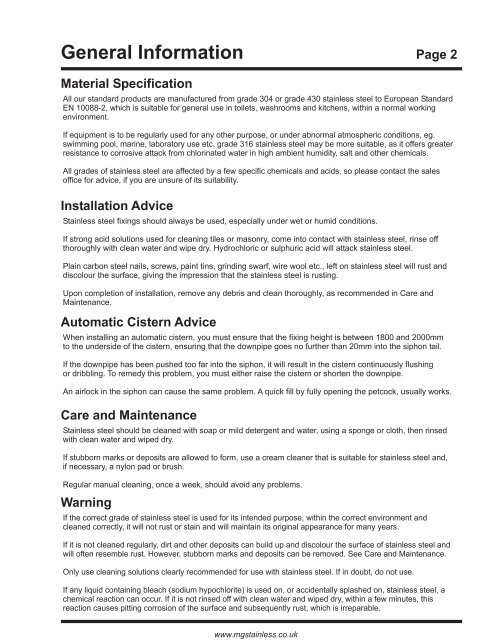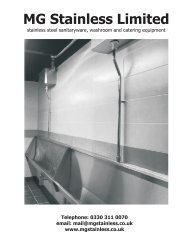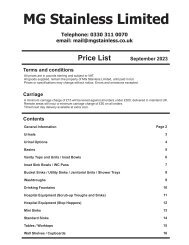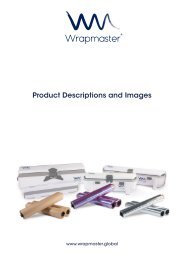REVISED PRICE LIST SEPTEMBER 2023
You also want an ePaper? Increase the reach of your titles
YUMPU automatically turns print PDFs into web optimized ePapers that Google loves.
www.mgstainless.co.uk<br />
General Information Page 2<br />
Material Specification<br />
All our standard products are manufactured from grade 304 or grade 430 stainless steel to European Standard<br />
EN 10088-2, which is suitable for general use in toilets, washrooms and kitchens, within a normal working<br />
environment.<br />
If equipment is to be regularly used for any other purpose, or under abnormal atmospheric conditions, eg.<br />
swimming pool, marine, laboratory use etc. grade 316 stainless steel may be more suitable, as it offers greater<br />
resistance to corrosive attack from chlorinated water in high ambient humidity, salt and other chemicals.<br />
All grades of stainless steel are affected by a few specific chemicals and acids, so please contact the sales<br />
office for advice, if you are unsure of its suitability.<br />
Installation Advice<br />
Stainless steel fixings should always be used, especially under wet or humid conditions.<br />
If strong acid solutions used for cleaning tiles or masonry, come into contact with stainless steel, rinse off<br />
thoroughly with clean water and wipe dry. Hydrochloric or sulphuric acid will attack stainless steel.<br />
Plain carbon steel nails, screws, paint tins, grinding swarf, wire wool etc., left on stainless steel will rust and<br />
discolour the surface, giving the impression that the stainless steel is rusting.<br />
Upon completion of installation, remove any debris and clean thoroughly, as recommended in Care and<br />
Maintenance.<br />
Automatic Cistern Advice<br />
When installing an automatic cistern, you must ensure that the fixing height is between 1800 and 2000mm<br />
to the underside of the cistern, ensuring that the downpipe goes no further than 20mm into the siphon tail.<br />
If the downpipe has been pushed too far into the siphon, it will result in the cistern continuously flushing<br />
or dribbling. To remedy this problem, you must either raise the cistern or shorten the downpipe.<br />
An airlock in the siphon can cause the same problem. A quick fill by fully opening the petcock, usually works.<br />
Care and Maintenance<br />
Stainless steel should be cleaned with soap or mild detergent and water, using a sponge or cloth, then rinsed<br />
with clean water and wiped dry.<br />
If stubborn marks or deposits are allowed to form, use a cream cleaner that is suitable for stainless steel and,<br />
if necessary, a nylon pad or brush.<br />
Regular manual cleaning, once a week, should avoid any problems.<br />
Warning<br />
If the correct grade of stainless steel is used for its intended purpose, within the correct environment and<br />
cleaned correctly, it will not rust or stain and will maintain its original appearance for many years.<br />
If it is not cleaned regularly, dirt and other deposits can build up and discolour the surface of stainless steel and<br />
will often resemble rust. However, stubborn marks and deposits can be removed. See Care and Maintenance.<br />
Only use cleaning solutions clearly recommended for use with stainless steel. If in doubt, do not use.<br />
If any liquid containing bleach (sodium hypochlorite) is used on, or accidentally splashed on, stainless steel, a<br />
chemical reaction can occur. If it is not rinsed off with clean water and wiped dry, within a few minutes, this<br />
reaction causes pitting corrosion of the surface and subsequently rust, which is irreparable.
















